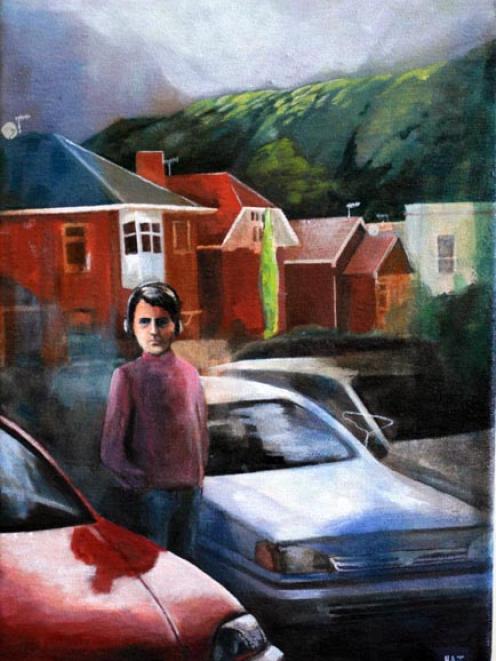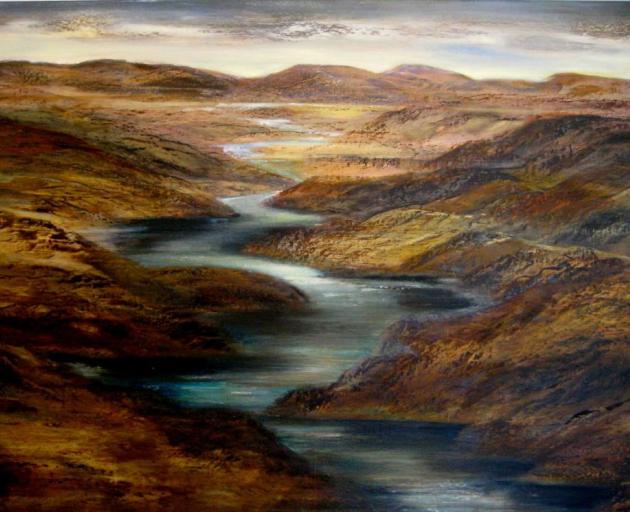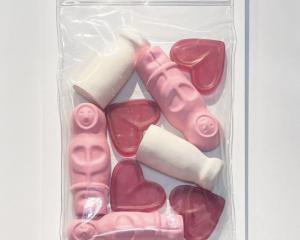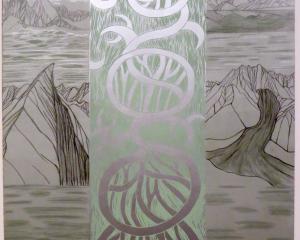
''Home Truths'', Joanna Braithwaite (Milford Galleries Dunedin)
Joanna Braithwaite's new show draws on national legends and narratives, uniting elements of history with personal memories and flights of whimsy.
Many of the works touch on the gold rush, and the gold fever that could become an obsession with those who risked their lives in the search for fortune and glory.
The gleam and sheen of gold paint in nuggets and flesh often contrasts with a dark, almost smoky background that seems to evoke dust, danger and a saloon atmosphere.
Braithwaite's style has the glossy opulence and staging of traditional portraiture, but her regally posed subjects are animals rather than human aristocrats.
The deliberate distortion of reality invites speculation into our misplaced values and our emphasis on class, money and status.
The most striking piece, Grand Times, features the endangered skinks that fascinate the artist with the hint of gold in their skin.
Two of the species sit in nonchalant arrogance, each clasping a sizeable chunk of gold, one lounging in throne-like splendour on an upholstered chair, the other perched on an expensive antique clock.
In Go for Gold, a third skink staggers under the weight of a nugget, determined to carry it and barely able to walk.
Good as Gold and Fool's Gold pay homage to a Victorian photograph of Skippers Canyon that featured a monkey sporting a cap and pipe, an early tourist attraction.
The pantomime image emphasises the romantic veneer that overlays legends of the goldfields.

"Strange Vacation'', Hannah Joynt (The Artist's Room, Dunedin)
Hannah Joynt's ''Strange Vacation'' is a series of vignettes of places and people, the vibrant landscapes and quirky portraits like snapshots from the titled journey.
Ghostly figures stand alongside their fleshier counterparts in the very effective The Waterfall and Meadow, seeming to unite the present and the past with fragments of memory and reminiscence.
The viewer feels that they are returning with the subject to a scene walked before, perhaps in company that has passed.
Even the more solid figures in works like Swing have a curiously distant quality, as if they are involved in their own world and business outside of their audience.
There is something incredibly appealing about Joynt's bright and evocative style, a universal quality to the scenes that seems to reach out and draw forth memories from the viewer as well as the artist.
The scenes of bush and fields, of children playing in water, might be from anyone's childhood; the gallery of miniature portraits are a stream of individualised strangers who might pass by on any street.
The treatment of light and shadow is remarkably well done, and the Afternoon Forest series is the most memorable and technically superior of the collection.
Shadows of figures and tree trunks stretch in dark streaks across sunlit fields, seeming to catch a single static moment in time before the light shifts or limbs move, and the scene will change.

''To the Wasteland - Following the Rivers of Gold'', Gail de Jong (Hullabaloo Art Space, Cromwell)
Early miners, with their eyes fixed on the distant glint of gold, traversed stretches of barren, perilous earth that they called the ''wasteland'', believed to border rivers teeming with treasure, a siren's call to those who ventured into the untamed landscape of Central Otago.
Inspired by a trip down the Clutha River, painter Gail de Jong also revisits the past days of splendour and suffering during the gold rush, focusing on the composition of the land and the sheer intimidation of its remote beauty.
De Jong's distinctive style involves the building up of layers of oil paint, as if mimicking the gradual deposit of rock and schist in the hills, and the effect is highly textural, capturing the tiniest particles of light and sediment.
Her colour palette gleams through shades of earthen brown and sun-touched amber, and there is a subtle wink of gold throughout, luring the miner on his journey and the viewer closer to the canvas.
De Jong notes ''poetry takes precedence over reality'' in her work, and there is a slightly mystical and dreamlike quality to the collection, as if the images might be illustrations of storybook legends.
That is particularly the case with A Way Through the Gorge, where the river has an opaque mirror-like sheen, reflecting the light and cannily keeping its contents a secret.
Sunshine touches the horizon, contrasting with the ominous dark of the land that must first be crossed.
- Laura Elliott







![Untitled (c. mid 1990s, [pink 3]), by Martin Thompson, 415mm×590mm. Photo: courtesy of Brett...](https://www.odt.co.nz/sites/default/files/styles/odt_landscape_small_related_stories/public/story/2024/02/untitled_pink_3.jpg?itok=Q0aQrc9o)




